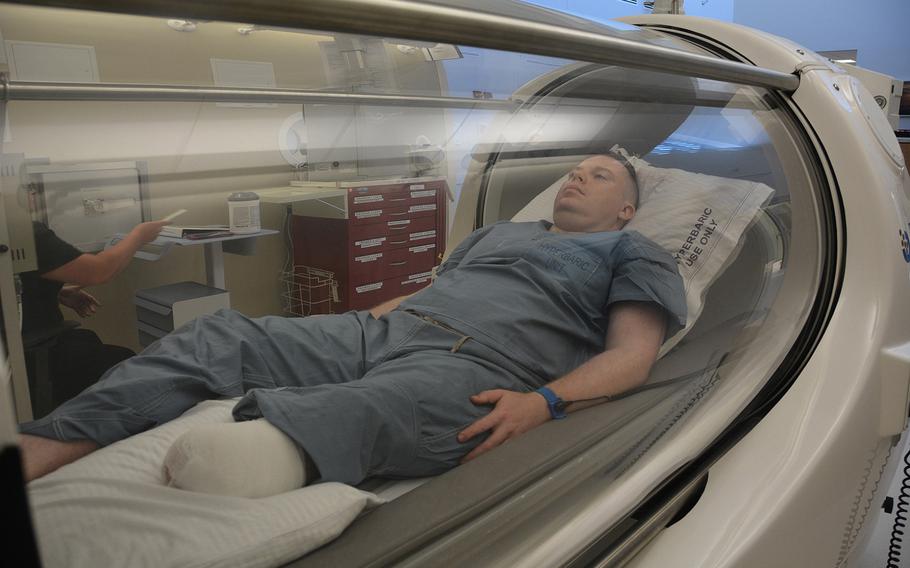
Army Capt. Kyle Salik is the first patient to receive oxygen therapy at the new Undersea & Hyperbaric Medicine Clinic at Brooke Army Medical Center June 20, 2017. (Robert Shields/U.S. Army)
WASHINGTON — Pressurized oxygen chambers, light-emitting helmets and neck injections are all treatments the Department of Veterans Affairs is using to help veterans with post-traumatic stress disorder and traumatic brain injury.
Following an announcement last week that the VA would offer hyperbaric oxygen therapy to some veterans with PTSD, the agency said Thursday that the move is part of an effort to explore alternatives to the traditional therapies for PTSD and TBI, VA Secretary David Shulkin said in a statement.
“We know that for a small group of veterans, a traditional approach to health care may not be the most effective,” Shulkin said. “With veterans who don’t improve, we have to look for innovative, evidence-based approaches that may help them restore and maintain their health and wellbeing.”
Shulkin has repeatedly cited suicide prevention as his No. 1 clinical priority and promised lawmakers “big, bold steps” toward that end.
The VA said light-emitting diode (LED) therapy is now being offered to veterans with mild or moderate TBI to use in their homes, or at the VA Boston Healthcare System in Jamaica Plain. It involves a light-emitting frame being placed on a patient’s head and a clip in their nose. The VA studied the treatment in 2015 and found it increases blood flow in the brain and affects damaged cells to possibly improve brain function.
At the Long Beach VA Medical Center in California, doctors have started using a method called stellate ganglion block for veterans with PTSD. The treatment consists of a shot of medication into a patient’s neck.
VA researchers published a report on the treatment in February stating they found improvements in PTSD symptoms after the first test, but progress dropped in subsequent trials. The study was inconclusive, and researchers called for more testing.
The VA said Thursday the treatment might ease anxiety.
A third alternative treatment, hyperbaric oxygen therapy, uses pressurized chambers to send higher oxygen levels to patients. For now, the VA is making the therapy available to a small number of veterans in the eastern Oklahoma and northern California VA health care systems.
The treatment has been federally approved for illnesses such as decompression sickness and carbon monoxide poisoning and to treat wounds that won’t heal. It hasn’t been proven to work for traumatic brain injury or PTSD, and the VA acknowledged it was an “off-label” use of the treatment.
The American Legion applauded the VA’s decision to use hyperbaric oxygen therapy, stating that they’ve been asking the VA to offer it – and other alternative methods to treat PTSD -- for more than four years.
Though studies by the VA and Department of Defense have been mostly inconclusive, the American Legion said the therapy was successful for many veterans and servicemembers and will be an “important new tool” for VA patients.
wentling.nikki@stripes.comTwitter: @nikkiwentling